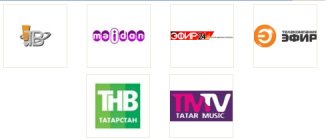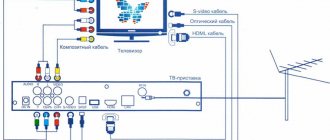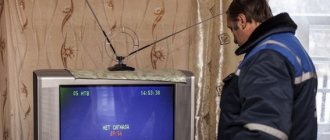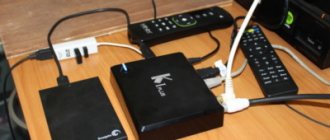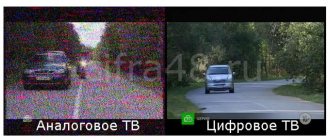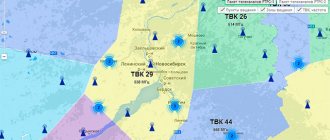Digital television in Orenburg, Questions and answers.
— In the Orenburg region, in accordance with the federal target program “Development of television and radio broadcasting in the Russian Federation for 2015–2017, a network of on-air digital terrestrial television broadcasting in DVB T-2 format was launched, broadcast by the Federal State Unitary Enterprise “Russian Tel” television and radio broadcasting network", Digital terrestrial television – modern television broadcasting technology. Thanks to digital data compression, it has become possible to transmit a larger number of TV channels in better quality and with additional information (subtitles, additional audio tracks, etc.).
That's how it works.
How to set up digital television in Orenburg?
Digital television broadcasts take place in the new digital standard DVB-T2. If the TV does not support the DVB-T2 standard, then to receive terrestrial digital television you will need a receiver (tuner) of the DVB-T2 standard. How to set up digital television reception through such a tuner.
There are no complicated settings for digital terrestrial television - setting it up is quite simple. You only need to scan all television channels on a DVB-T2 digital tuner in automatic mode. And this will end the entire setup of digital television.
What antennas may be required to receive DVB-T2 digital television? To receive terrestrial digital television, you need a UHF antenna. The frequency range of electromagnetic radiation, radio waves with a wavelength from 1 m to 10 cm, which corresponds to a frequency from 300 MHz to 3 GHz.
Can I use an indoor antenna for a good picture? The quality of the signal depends on the transmitter and its power and distance. The further you are from it, the worse the reception.
What antennas will pick up digital television? How much do such antennas cost and where can I buy them?
Digital indoor antenna and outdoor DVB-T2
Is it possible to receive a digital television signal without an antenna? Yes, if you are very close to the TV tower. If instead of an antenna you connect a piece of wire or a metal object. Perhaps the signal will be stable and strong, then you do not need an antenna.
How can I set up an antenna? Installation of the antenna is allowed on a window, loggia, or cornice. To mount an outdoor antenna, you will need a specialist antenna technician. A specialist will firmly install the antenna on the wall or roof so that it does not get torn off by the wind. The higher the antenna is raised, the better and stronger the signal. After setting up the TV, check the reception quality and repeat the settings if necessary. When placing the antenna on the roof, provide protection from lightning strikes.
Where can I buy an antenna for digital television? You can buy an antenna at any store that sells equipment for receiving digital signals (computer showrooms, radio markets). But you can look at Teledrug Stores. Don’t forget to warn the seller that you need an antenna for digital television. You don’t have to buy an antenna, but connect an existing one if its parameters are suitable for receiving terrestrial digital television in Orenburg.
Will over-the-air digital television work from cable television? Unfortunately there will be no reception, because... Cable TV companies supply the digital signal either in another broadcast standard (DVB-C) or in a regular, analogue format
Is it possible to watch digital terrestrial television at the same time as cable television? It is possible to connect a DVB-T2 digital receiver to the TV, then you can install an antenna splitter (tee), connect both cable television and a UHF antenna to receive digital television
This is what a DVB-T2 digital tuner (receiver) looks like
DVB-T2 digital television, what should I do?
It is necessary to install a digital set-top box, connect it with a cable to the TV and antenna. You will have two remote controls, for the TV and for the digital set-top box. But many users complain about the inconvenience associated with the many wires and remote controls.
Satellite television.
For connoisseurs of a good image, you need to install satellite digital television - Tricolor-TV High signal quality, a lot of channels for every taste
.
Tricolor TV is the largest Russian operator of FULL-HD . It provides digital television broadcasting services to the European territory of Russia (since 2005), as well as the territory of the Siberian and part of the Far Eastern districts (since 2008). Broadcasting to the European part of the Russian Federation is carried out from the Earth satellites Eutelsat W4 and Eutelsat W7 (36 east), and to the eastern regions (the Tricolor TV Siberia project) - from the Bonum-1 satellite (56 east).
Tricolor TV includes more than 300 MPEG-4 and HD TV channels.
Call a technician to install Tricolor TV: Orenburg
Our main advantage is a free package of federal TV channels, the largest in comparison with the offers of other satellite television operators. We offer to connect TV channels of your choice to the free package: - Slot for a DRE Crypt conditional access smart card
-Reception of Tricolor TV channels in DVB-S:QPSK, and DVB-S 8PSK format:
-To view the “Tricolor Full HD” package: reception in SD and HD formats -Connectors: composite video, stereo audio output, USB connector, HDMI connector, loop antenna output -Graphical interface: colors -Reception of high definition and standard definition TV channels in MPEG formats -4 AVC/H.264 and MPEG-2 FULL-HD -Menu languages: Russian, English -TV mail, TV chat, Infokas -Detailed electronic program guide (EPG) for 7 days -DRECrypt v. 3.0 -Timer -Teletext, subtitles support for different image formats (4:3,16:9)
The introduction of digital technologies into televisions began, perhaps, since the beginning of the use of Remote Controls. Programming with a binary code of packets of pulses transmitted by IR LEDs, as well as the technical organization of control units for volume, brightness, contrast, and saturation, required the use of counters, decoders, triggers, DAC and ADC devices, and other digital elements for implementation.
Subsequently, special processors using the I2C (serial interface) standard data exchange bus and non-volatile EEPROM memory were developed to control and store operational adjustments and television channels. Back in the mid-90s, some TV models used digital processing of color signals. Since the beginning of this century, digitally controlled tuners, as well as video and audio processors, have begun to be used on a larger scale. The use of digital video signal processing with frame decomposition and storage made it possible to implement hundred-hertz CRT televisions and use progressive scan in them, which significantly improved image quality. With the growing popularity of computers and the advent of LCD and plasma TVs, digital technologies began to integrate with television technologies more and more effectively. Transferring images from computers to TV has become possible through digital interfaces DVI, HDMI, USB. The use of graphic and video formats on televisions, in particular MPEG-4, as well as other PC-compatible applications, has given rise to even greater progress and opportunities, for example, the transmission of digital content via wireless communications. There are TVs with DVB tuners, as well as Smart TVs with Internet connectivity.
Digital television Digital television (DTV - Digital TV) is the use of digital data transmission in television devices and systems. Currently, the term Digital Television in everyday life usually means digital broadcasting DVB (Digital Video Broadcasting), used in terrestrial, cable and satellite television systems. Or interactive IPTV television broadcast by Internet providers via network channels. Digital broadcasting DVB DVB-T - (T - Terrestrial) terrestrial broadcasting in the UHF range. DVB-T2 is a second generation terrestrial broadcasting using new modulation and channel coding modes, which doubles the communication channel capacity. This standard is not compatible with DVB-T. DVB-S - (S - Satellite) satellite broadcasting in the centimeter wave range. DVB-S2 - second generation satellite broadcasting. Same as DVB-S with increased communication channel capacity. DVB-SH - (SH - Satellite Handheld) satellite broadcasting with mobile reception capabilities. DVB-C - (C - Cable) cable broadcasting. DVB-C2 - second generation cable broadcasting. DVB-H - (H - Handheld) mobile broadcasting. DVB-IPDC - (IPDC - IP Datacast) data transmission via internet protocol. Transfers over IP networks. DVB 3D-TV - Three-dimensional broadcasting. Transmission of 3D video in digital terrestrial (DVB-T, DVB-T2), satellite (DVB-S, DVB-S2) and cable (DVB-C, DVB-C2) television.
Opportunities for receiving DVB digital broadcasting Currently, cable television organizers widely use the transmission of video and audio television signals over cable networks in the DVB-C and DVB-C2 standards, usually providing their subscribers with set-top boxes - decoders with a tuner of the corresponding standard. Also, in many cities and regions of Russia, since 2012-2013, in the UHF range, television centers began free broadcasting of the channels of the first and second digital multiplex of the DVB-T or DVB-T2 standard, which includes 20 channels of domestic television companies. Information about DVB-T2 digital television in Orenburg can be read at the link: https://orenburg.rtrn.ru/dtv/, as well as https://dvbpro.ru/
To receive over-the-air or cable channels, you need a TV with a tuner capable of receiving and processing a signal of the appropriate standard. If you have an old TV, then you need to purchase a set-top box for receiving a digital television signal in DVB-T2 format with an antenna for the UHF range.
The digital broadcasting standards that a TV or receiver supports are indicated in their technical specifications or advertising brochures. For example, for Samsung TVs whose model name ends with the number “7”: LED TVs of the EH5307, ES5507, ES5537, EH6037, ES6307, ES6547, ES6557, ES6727, ES6757, ES6857, ES6907, ES7207, ES7507, ES8007, etc. series, plasma TV series E497, E537, E557, E6507, E8007 and others have a built-in DVB-T2 tuner. (For more details, see https://www.samsung.com/ru/consumer/tv-av/tv/)
Interactive television In recent years, Internet service providers have been implementing interactive television projects using IPTV data transmission technology. Subscribers are provided with special IPTV-SetTopBox set-top boxes, which can be connected to the TV using the HDMI digital interface to view programs and films in HD quality, or using conventional connectors such as SCART or RCA (tulips) for standard TV quality. Such connections can use the ability to provide a full range of services: high-speed Internet and WiFi communications, telephony and digital television, which allows subscribers to refuse to use telephone and coaxial cables in wiring. The above project is being successfully and large-scale implemented by Rostelecom. There are also alternative options for interactive television in combination DVB/IPTV, where all analog and digital TV channels are broadcast via coaxial cable, and the provider provides set-top boxes or CAM modules to control the interactive service.
So let’s look at what the so-called first, second, and in the future the third package of the multiplex of digital television channels in Russia represents.
First digital multiplex (RTRS-1)
The first digital multiplex or the first package of digital channels of the Russian Television and Radio Broadcasting Network (RTRS-1) is a package of all-Russian, publicly accessible and free television and radio resources for the population.
The list of all-Russian channels that should be available throughout the country was approved by the decree of the President of Russia “On all-Russian mandatory public television and radio channels” on June 24, 2009. The decree noted that the list of channels was compiled to preserve the general information space of Russia, as well as to provide citizens of the country with socially significant information. The law emphasizes that all radio and television channels on this list must be available to all Russians completely free of charge.
The State Commission on Radio Frequencies approved the frequency-territorial plan of RTRS-1 in 2009. Broadcasting of the digital package in Russia is carried out in the decimeter range from 470 to 862 MHz.
In 2012, the Russian government determined that the optimal broadcast standard for the RTRS-1 digital package is DVB-T2, the format is SDTV standard definition. It should be noted that before 2012, some regions had already been transferred to digital broadcasting, but in a different format. As a result, it was decided to transfer all subjects of Russia to one DVB-T2 standard.
The terrestrial digital package is broadcast free of charge and cannot be encrypted because the multiplex must be accessible to everyone.
For commercial or non-terrestrial broadcasting, the concept of RTRS-1 is not defined, but the law states that all operators are required, at their own expense, to broadcast public channels on their networks without making changes to them.
In Moscow, the first multiplex is broadcast on 30 TVCs at a frequency of 546 MHz in the DVB-T2 standard. In Orenburg, the broadcast is carried out on channel 22 at a frequency of 482 MHz, also in the DVB-T2 standard.
| № | Name | Format | Frequency in Moscow / Orenburg | Owner |
| 1 | First channel | 16:9 | 546 MHz / 482 MHz | OJSC "Channel One" |
| 2 | Russia 1 | 4:3 | FSUE "All-Russian State Television and Radio Broadcasting Company" | |
| 3 | Match TV | 16:9 | JSC Gazprom-Media Holding | |
| 4 | NTV | 16:9 | OJSC "Television Company NTV" | |
| 5 | Channel 5 | 4:3 | OJSC Teleradio |
The second Russian digital television multiplex (RTRS-2)
The second digital multiplex or the second package of digital channels of the Russian Television and Radio Broadcasting Network (RTRS-2) is the next package of all-Russian, but not obligatory digital TV channels. The list of channels in the second package was compiled based on the results of a Roskomnadzor competition. If the TV resources of the first RTRS-1 are required to be distributed free of charge in all networks, then commercial operators decide on their own whether to distribute the second package for free.
In 2009, the State Commission on Radio Frequencies assigned the decimeter range from 470 to 862 MHz to the second digital TV package. Broadcasting is carried out by Federal State Unitary Enterprise RTRS, the standard is DVB-T2, the format is SDTV standard definition.
The second multiplex, like the first, is distributed free of charge and its signal is also not encrypted. All channels of the second package are known to subscribers of satellite, cable and IP television. The channels did not receive any special advantages when they were included in the RTRS-2 list, since these resources are not mandatory. In addition, analogue broadcasting of most of these resources is already present on the air in large cities. Operators provide subscribers with access to these channels in the cheapest subscription fee package or free of charge.
In Moscow, the second multiplex is broadcast on 24 TVCs at a frequency of 498 MHz in the DVB-T2 standard. In Orenburg, the broadcast is carried out on channel 28 at a frequency of 530 MHz, also in the DVB-T2 standard.
| № | Name | Format | Frequency in Moscow / Orenburg | Owner |
| 1 | REN TV | 16:9 | 498 MHz / 530 MHz | LLC "Accept" |
| 2 | Saved | 4:3 | Financial economic management of the Russian Orthodox Church and SPAS-Media LLC | |
| 3 | STS | 4:3 | CJSC Network of Television Stations | |
| 4 | Home | 4:3 | CJSC "New Channel" | |
| 5 | TV-3 | 4:3 | Profmedia TV LLC | |
| 6 | Friday! | 4:3 | Profmedia TV LLC | |
| 7 | Star | 16:9 | OJSC "TRK RF Armed Forces "Zvezda"" | |
| 8 | World | 16:9 | CJSC "Interstate TV and Radio Company "Mir"" | |
| 9 | TNT | 4:3 | OJSC "TNT-Teleset" | |
| 10 | Muz TV | 4:3 | Muz TV Operating Company LLC |
The third digital television multiplex in Russia
The third digital multiplex is just a planned package, which will include federal and regional TV channels. The decree on the formation of RTRS-3 was signed by the President of Russia in 2013.
Currently, the Ministry of Communications and Mass Communications of the Russian Federation has postponed the launch of the third package of RTRS-3 for an indefinite period.
Detailed information about digital broadcasting packages can be found at: https://www.tv-digest.ru/cifrovoe_tv/
Transition to digital TV: what do residents of the Orenburg region need to know?
TV tower in Orsk
Until October 14 of this year,
the Orenburg region
will switch to digital television broadcasting. What does the abolition of analog television mean, how to prepare for the transition to digital, do you need to buy equipment, how much will it cost, will this affect cable operators? Read about everything in our material.
Why are analogue television broadcasts turned off?
The analog signal can be picked up using an antenna. At the same time, today the analog signal is considered obsolete. The disadvantage of such television is the vulnerability of the signal to interference, which leads to worse image and sound quality. In this regard, the government decided to transfer Russia to digital broadcasting. This type of TV has better picture and sound. In addition, it is possible to connect channels in HD quality.
What channels were available on analogue broadcasts?
Analogue broadcasting was free. Residents of the Orenburg region watched 8 channels: “Channel One”, “Russia 1”, “Channel Five”, NTV, STS, TNT, “ORT-Planeta”, “Culture”.
What channels will be on digital broadcasting?
In the new broadcast, 20 channels will be available to residents of the region: Channel One, “Russia 1”, “Match TV”, NTV, “Channel 5”, “Russia-Culture”, “Russia 24”, “Carousel”, OTR, “TV” , STS, Domashny, TV3, Friday, Zvezda, Mir, TNT and MuzTV. The first multiplex also included three radio programs: “Radio Russia”, “Mayak”, “Vesti FM”.
Do I need to pay for digital broadcasting?
Console. Photo from the site orenburg.rtrs.ru
Unlike users of cable and satellite operator networks, viewers of digital terrestrial television will not pay a subscription fee.
If you have an old TV, in order to watch terrestrial digital TV, you just need to buy special equipment - a receiver (tuner) of the DVB-T2 standard. The set-top box must be connected with a cable to the TV and antenna. You will have two remote controls, one for the TV and one for the digital set-top box.
The average cost of a set-top box is 1.5 - 2 thousand rubles, you can also find a budget analogue priced from 700 rubles.
If I have a modern TV, do I need an antenna?
Antennas. Photo from the site orenburg.rtrs.ru
Most modern TVs support the DVB-T2 broadcast standard, which broadcasts free multiplexes*. Most likely, they will not have to buy an antenna. However, if you can’t tune in the channels, you need to buy a UHF antenna. The cost of a decimeter antenna is from 300 rubles.
*TVs released after 2014 usually all support DVB-T2.
How to get a set-top box for free?
By the way, the government of the Orenburg region has established a measure of social support to provide financial assistance for the purchase of user equipment for receiving a digital signal (a set of satellite equipment).
Material assistance from the regional budget will be provided to Orenburg residents living outside the coverage area of digital terrestrial television broadcasting - low-income families or low-income single citizens who do not have appropriate equipment. The amount of material assistance depends on upcoming expenses, but not more than 3,500 rubles.
The condition for recognizing a family or single citizens as low-income is that the average per capita income must be below the subsistence level per capita.
You can apply for financial assistance until December 31, 2019. Applications and documents are accepted by specialists from comprehensive social service centers and MFCs. The application can be submitted electronically on the government services portal.
What if I have cable TV?
If you use cable television (Ufanet, Rostelecom, Dom.Ru and others), then nothing will change for you. You will pay for channels at the rate set by your cable operator. At the same time, operators have both analogue and digital broadcasting.
About interactive television
Interactive television or IPTV is the latest word in telecommunications.
It combines broadband Internet access and digital TV. Compared to analogue, satellite and cable television, IPTV offers users maximum control over the content and viewing experience, as well as Internet access from the TV screen. At the moment, any major provider of digital television, broadband Internet and mobile telephony already has its own IPTV system. The most famous: Rostelecom, VimpelCom (Beeline), MTS, Megafon, TTK and others.
The standard cost of a set of equipment for interactive television is about 4,000 rubles. The monthly subscription fee is about 220–350 rubles (the basic tariff often includes more than 100 TV channels).
Analog TV has been switched off, but that doesn't mean you need to buy a set-top box
Analog broadcasting of federal channels in the Orenburg region has been stopped (let’s immediately say that not all of them, read more below). BUT! Cable TV subscribers don't have to worry about this! After all, this innovation will not affect them in any way: just as they watched their nth number of channels, and even local ones, we will watch them!
Elena Zuikova, director
On October 14, terrestrial analogue television was switched off due to the government transition to digital broadcasting. I would like to tell clients, especially our clients, of course, that for any subscriber of any cable operator everything remains the same. That is, how you received the service and a certain number of channels - everything remains the same. Nowadays we have people getting confused, calling, buying set-top boxes for some reason, by mistake, our clients. There is no need to do this. That is, you receive the service in full quality, in the same volume as before.
In general, let's remember what analog TV .
Remember that huge number of antennas that stood on the roofs of houses? They caught the signal from the transmitter on the TV tower, transmitted it to the TV and you could watch your favorite shows. This is exactly the same analog television.
Digital television has become an alternative to analogue. The picture is better quality and the signal is faster. But it’s impossible to say that analog TV has disappeared; it simply stopped being funded. And therefore it is worth highlighting the most important points.
№1. For subscribers of any cable operator, absolutely nothing has changed! As they watched their several dozen channels, they continue to watch. So if you have a cable connected to your TV, everything remains the same.
No. 2. If your TV picks up a signal using a good old antenna, analogue television remains ! It’s just that instead of the previous eight channels, four are now available. These are STS, NTV, ORT-Planet , and what the fourth one will show is still being discussed. On these four channels you can watch federal, regional, and local news, favorite programs, films - everything as before.
No. 3. Well, now a few words about the so-called free digital broadcasting . Yes, residents will have access to 20 channels. The only BUT : in order to watch digital TV, you need a special set-top box that will receive a digital signal. You must pay for it out of your own pocket. What if you want to watch different programs? For example, on one TV there is football, and on the other there is a popular talk show - you will have to fork out for two (!) set-top boxes. Another option is a modern, sophisticated TV with already installed equipment. But it also costs several times more than what you have. And one more huge minus: “on digital” they do not show local news, only small inclusions(
№4. If you use satellite TV services, then nothing has changed for you either.
So, let's repeat the main idea:
— nothing has changed for cable TV subscribers,
— analogue broadcasting will remain: 4 free channels are available to citizens.
Elena Zuikova, director
Call us on our free 24/7 phone line 8-800-222-66-07 , if anyone has any questions, we will always help and tell you, even if you are not our client.
And one more thing: be careful! In connection with the changes, volunteers are working for all those who still decide to use digital set-top boxes. CAUTION: scammers decided to take advantage of the situation; they also go door to door, posing as volunteers, but in fact their intentions are selfish - to steal and deceive. Real volunteers always have a personal book with them - a document issued by the Youth Policy Department of the Orenburg Region. The book must contain the last name, first name, patronymic, year of birth, profession, education, educational institution and date of issue. The document must also contain a photograph and a stamp confirming the accuracy of the specified data.
If the “volunteer” who came to you could not show this document, call the police. And don’t let such false helpers into your home!

